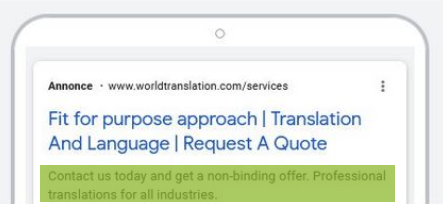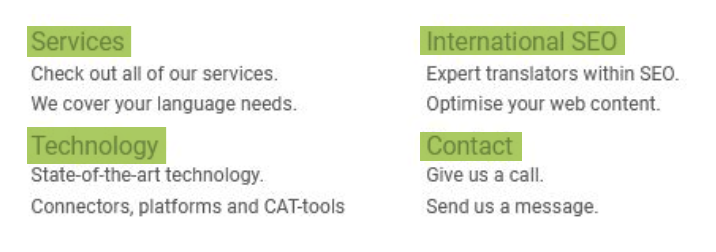Most companies today are familiar with SEO (Search Engine Optimisation) and use it actively on their websites. However, if you want to give your site an added boost across the various search engines, it might well be worth considering Search Engine Advertising (SEA) as well. Using SEA can help you achieve one of the treasured top placements on search engine lists, thus raising your visibility in the results.
However, while working with SEA in your own language may seem relatively straightforward, have you thought about the challenges inherent in creating advertisements in other languages? Working with SEA in foreign languages can be demanding, but in return it can prove a highly effective way to increase traffic to your website.
WHAT IS SEA?
For many people, SEA is probably still a relatively new tool in their marketing toolbox. SEA gives advertisers the opportunity to raise their profile through the use of relevant keywords and to control precisely what is displayed. This can make it easier to reach potential customers who are using search engines to find businesses like yours. Below are four important aspects you need to work with in your SEA.
KEY COMPONENTS IN YOUR SEARCH ENGINE ADVERTISEMENTS
|
A title that features relevant and captivating keywords. The title is the biggest and most eye-catching component.
A URL to display, which contains a path to the landing page on your site that the search engine user will access by clicking the link.
A descriptive text that highlights the most important information in relation to the product/service the search engine user is looking for.
|
WHY SEA?
WHAT CAN IT DO FOR YOUR BUSINESS?
Working with SEA in foreign languages can be both challenging and time-consuming. That said, it can also pay dividends in the long run.
This is because Search Engine Advertising lets you aim for a place among the first results displayed to search engine users who are looking for what you can provide. This, in turn, can help you convert search engine users into valuable customers for your business – at international level as well.
We offer to translate your SEA texts so that you can be sure of interacting with the right target group, even on markets other than your “home turf”.
WHAT GOES INTO TRANSLATING SEA?
When we translate your SEA texts, we typically start by looking at your existing SEO texts, if any. If you have already defined and validated a number of keywords, there is much to gain by including them in your terminology database (or creating such a database if you don’t already have one). In this way, we can draw on that database during the translation process, using it as a kind of dictionary of your keywords. This allows us to streamline the process and ensure you achieve coherent marketing across the various search engines. Working with our translators who specialise in SEA, you can be sure of effective SEA in all the languages relevant to your business, enabling you to make the most of your advertisements.
Do you not have any validated keywords yet? We can help you with that!

WHICH SEARCH ENGINE WILL YOU BE USING?
Google is the biggest and best-known search engine, but that does not mean it is your only option in the field of SEA. We generally focus on Google Ads, but if you use other search engines, we will, of course, handle the specific requirements on your advertising content that are relevant to these engines.
WHAT REQUIREMENTS NEED TO BE MET?
The work to translate your SEA content demands a fair amount of preparation. We need a good deal of information from you, and this entails a close working relationship and good communication between you, our project managers and our skilled translators. The reason for this is that it can be difficult to implement keywords because they are often taken out of context and need to be translated for advertising texts with limited space – without losing their intended meaning.
For example, imagine that you work for a company that manufactures and sells construction machines. At your company, you have naturally already determined what you call your products. Let us assume that you manufacture a “tower crane”, a “crawler crane” and an “all-terrain crane”. This last can also be called a “rough-terrain crane”, but you have classified this as a prohibited term (for example, because it may already be strongly linked to one of your competitors).
Now imagine that your preferred terms have been translated into five other languages. Among these may well be German and French, which have a reputation of being languages that feature looong words with lots of letters and syllables. So while it is one thing to have selected appropriate translations, it is quite another to have these potentially extensive keywords adapted to your advertising texts, where space may be tightly limited. This is where challenges may arise.
HOW DO WE DEAL WITH LENGTH RESTRICTIONS?
When you work with SEA, there will always be length restrictions on the phrases you use, because there are physical limits to the amount of display space in search engines. This can become quite a challenge when translating marketing texts into other languages. For this reason, the translator will have been briefed in advance to take the number of words or keystrokes into account during the translation process.
Some languages are more wordy than others, so the translator may be required to come up with extremely concise translations. The translator will typically start by removing superfluous words to shorten the sentences and phrases as much as possible, without compromising on the intended meaning, legibility and ease of comprehension.
If it is not sufficient to cut the text to the bone in this way, the next step is to introduce relevant abbreviations – in close consultation with you. In principle, it will always be possible to shorten words so that they comply with length restrictions, but in this context it is also essential to consider whether the words are being shortened so much that the sentence becomes unintelligible. If this happens, we will work with you to come up with a better solution.
In this way, you always have a great deal of influence because the emphasis is on your requirements with regard to length restriction.
Would you also like help to be among the top results in search engines on all your markets?
We can help with the translation of content for all your markets, as well as with the validation and implementation of the relevant keywords. What is more, our translators are experienced in working with SEA. They do not “just” possess extensive knowledge of the area, they are also used to working with length restrictions and skilled at inserting the right keywords in the right places. And it is not only your content we can translate; we can also work on your title tags, URLs and advertisement extensions.








